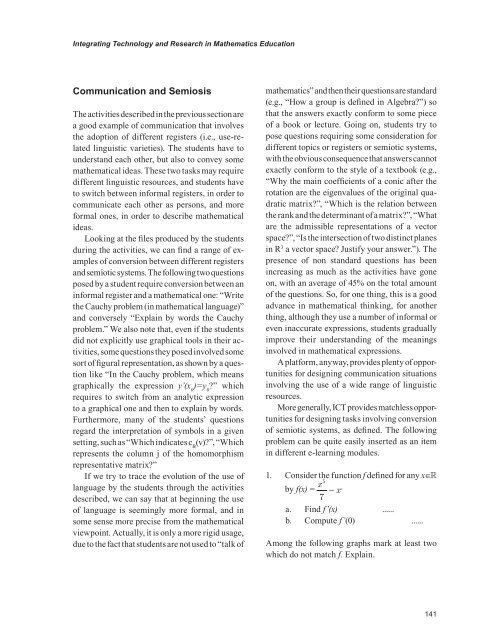Advances in E-learning-Experiences and Methodologies
You also want an ePaper? Increase the reach of your titles
YUMPU automatically turns print PDFs into web optimized ePapers that Google loves.
Integrat<strong>in</strong>g Technology <strong>and</strong> Research <strong>in</strong> Mathematics Education<br />
communication <strong>and</strong> semiosis<br />
The activities described <strong>in</strong> the previous section are<br />
a good example of communication that <strong>in</strong>volves<br />
the adoption of different registers (i.e., use-related<br />
l<strong>in</strong>guistic varieties). The students have to<br />
underst<strong>and</strong> each other, but also to convey some<br />
mathematical ideas. These two tasks may require<br />
different l<strong>in</strong>guistic resources, <strong>and</strong> students have<br />
to switch between <strong>in</strong>formal registers, <strong>in</strong> order to<br />
communicate each other as persons, <strong>and</strong> more<br />
formal ones, <strong>in</strong> order to describe mathematical<br />
ideas.<br />
Look<strong>in</strong>g at the files produced by the students<br />
dur<strong>in</strong>g the activities, we can f<strong>in</strong>d a range of examples<br />
of conversion between different registers<br />
<strong>and</strong> semiotic systems. The follow<strong>in</strong>g two questions<br />
posed by a student require conversion between an<br />
<strong>in</strong>formal register <strong>and</strong> a mathematical one: “Write<br />
the Cauchy problem (<strong>in</strong> mathematical language)”<br />
<strong>and</strong> conversely “Expla<strong>in</strong> by words the Cauchy<br />
problem.” We also note that, even if the students<br />
did not explicitly use graphical tools <strong>in</strong> their activities,<br />
some questions they posed <strong>in</strong>volved some<br />
sort of figural representation, as shown by a question<br />
like “In the Cauchy problem, which means<br />
graphically the expression y’(x 0<br />
)=y 0<br />
?” which<br />
requires to switch from an analytic expression<br />
to a graphical one <strong>and</strong> then to expla<strong>in</strong> by words.<br />
Furthermore, many of the students’ questions<br />
regard the <strong>in</strong>terpretation of symbols <strong>in</strong> a given<br />
sett<strong>in</strong>g, such as “Which <strong>in</strong>dicates c B<br />
(v)?”, “Which<br />
represents the column j of the homomorphism<br />
representative matrix?”<br />
If we try to trace the evolution of the use of<br />
language by the students through the activities<br />
described, we can say that at beg<strong>in</strong>n<strong>in</strong>g the use<br />
of language is seem<strong>in</strong>gly more formal, <strong>and</strong> <strong>in</strong><br />
some sense more precise from the mathematical<br />
viewpo<strong>in</strong>t. Actually, it is only a more rigid usage,<br />
due to the fact that students are not used to “talk of<br />
mathematics” <strong>and</strong> then their questions are st<strong>and</strong>ard<br />
(e.g., “How a group is def<strong>in</strong>ed <strong>in</strong> Algebra?”) so<br />
that the answers exactly conform to some piece<br />
of a book or lecture. Go<strong>in</strong>g on, students try to<br />
pose questions requir<strong>in</strong>g some consideration for<br />
different topics or registers or semiotic systems,<br />
with the obvious consequence that answers cannot<br />
exactly conform to the style of a textbook (e.g.,<br />
“Why the ma<strong>in</strong> coefficients of a conic after the<br />
rotation are the eigenvalues of the orig<strong>in</strong>al quadratic<br />
matrix?”, “Which is the relation between<br />
the rank <strong>and</strong> the determ<strong>in</strong>ant of a matrix?”, “What<br />
are the admissible representations of a vector<br />
space?”, “Is the <strong>in</strong>tersection of two dist<strong>in</strong>ct planes<br />
<strong>in</strong> R 3 a vector space? Justify your answer.”). The<br />
presence of non st<strong>and</strong>ard questions has been<br />
<strong>in</strong>creas<strong>in</strong>g as much as the activities have gone<br />
on, with an average of 45% on the total amount<br />
of the questions. So, for one th<strong>in</strong>g, this is a good<br />
advance <strong>in</strong> mathematical th<strong>in</strong>k<strong>in</strong>g, for another<br />
th<strong>in</strong>g, although they use a number of <strong>in</strong>formal or<br />
even <strong>in</strong>accurate expressions, students gradually<br />
improve their underst<strong>and</strong><strong>in</strong>g of the mean<strong>in</strong>gs<br />
<strong>in</strong>volved <strong>in</strong> mathematical expressions.<br />
A platform, anyway, provides plenty of opportunities<br />
for design<strong>in</strong>g communication situations<br />
<strong>in</strong>volv<strong>in</strong>g the use of a wide range of l<strong>in</strong>guistic<br />
resources.<br />
More generally, ICT provides matchless opportunities<br />
for design<strong>in</strong>g tasks <strong>in</strong>volv<strong>in</strong>g conversion<br />
of semiotic systems, as def<strong>in</strong>ed. The follow<strong>in</strong>g<br />
problem can be quite easily <strong>in</strong>serted as an item<br />
<strong>in</strong> different e-learn<strong>in</strong>g modules.<br />
1. Consider the function f def<strong>in</strong>ed for any x∈<br />
5<br />
x<br />
by f(x) = − x .<br />
7<br />
a. F<strong>in</strong>d f’(x) ......<br />
b. Compute f’(0) ......<br />
Among the follow<strong>in</strong>g graphs mark at least two<br />
which do not match f. Expla<strong>in</strong>.


